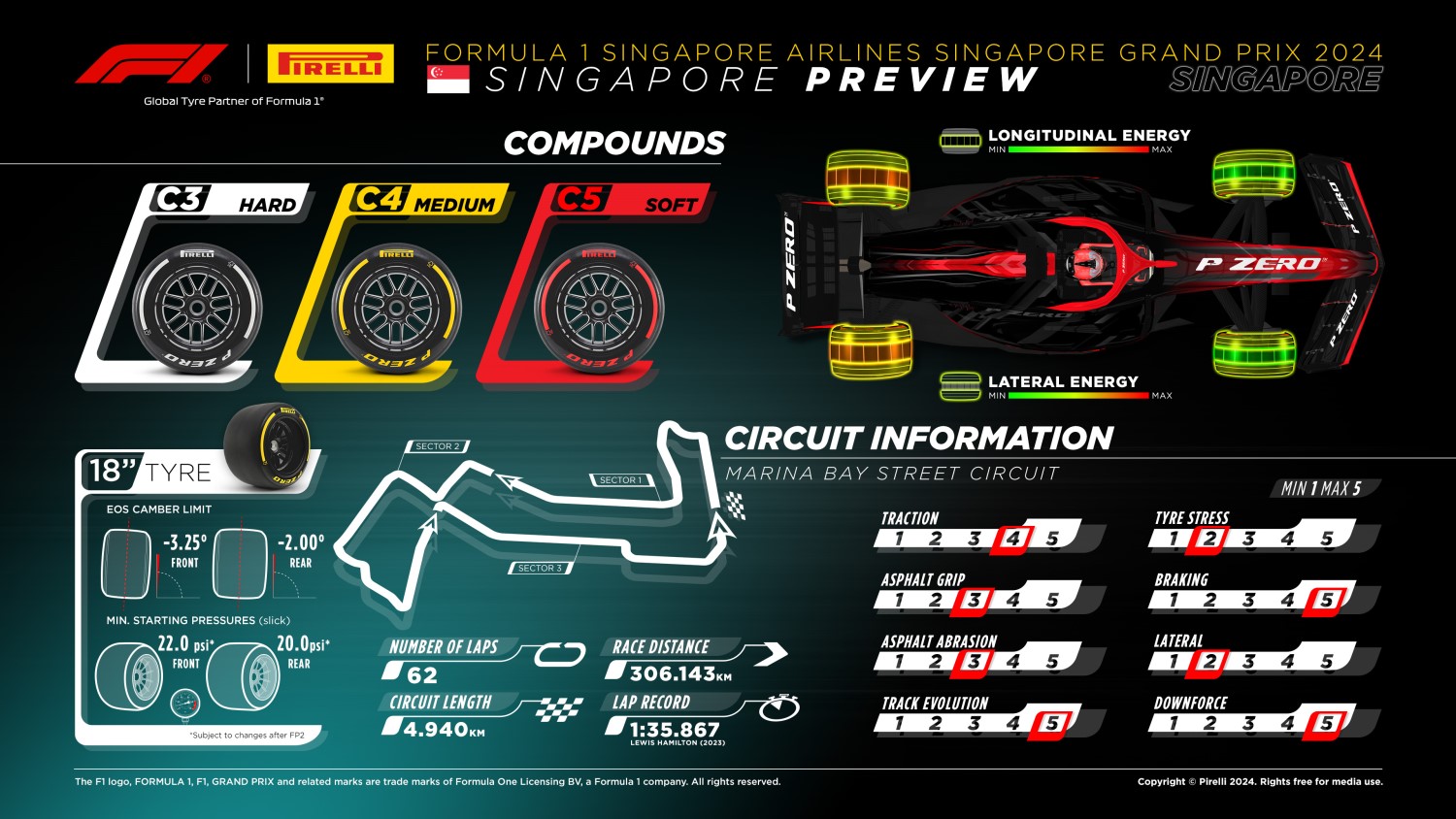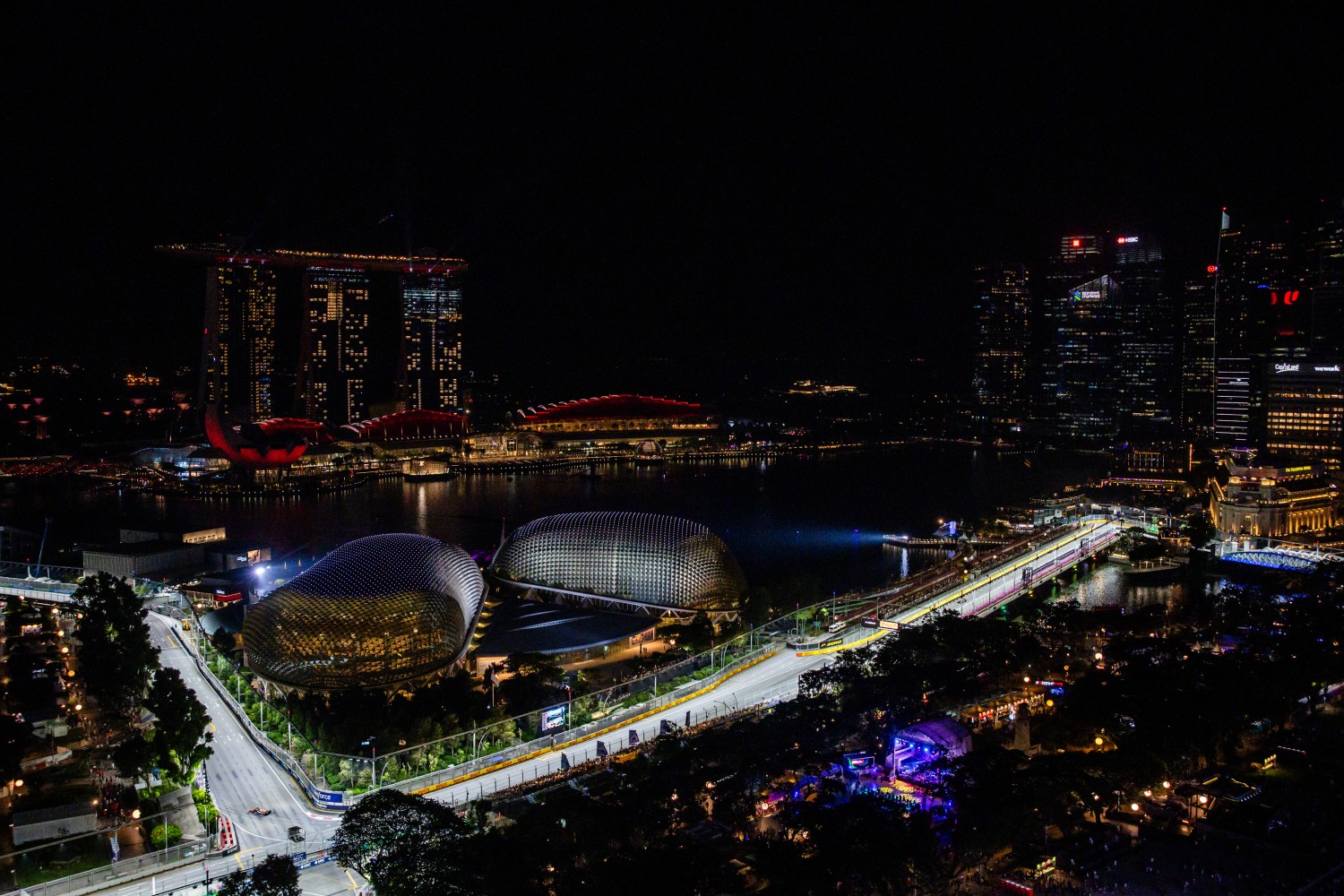Formula 1 News: 2024 Singapore GP at Marina Bay Preview
Formula One racing makes its return to Singapore this coming weekend for the 15th time at the floodlit Marina Bay street circuit.
Singapore joined Formula 1’s calendar in 2008 with a circuit mapped out around some of the city’s most eye-catching landmarks. Singapore broke new ground as Formula 1’s first night race, with thousands of lights illuminating the course, and the floodlit buildings provide a stunning backdrop to a high-speed pursuit through the city.
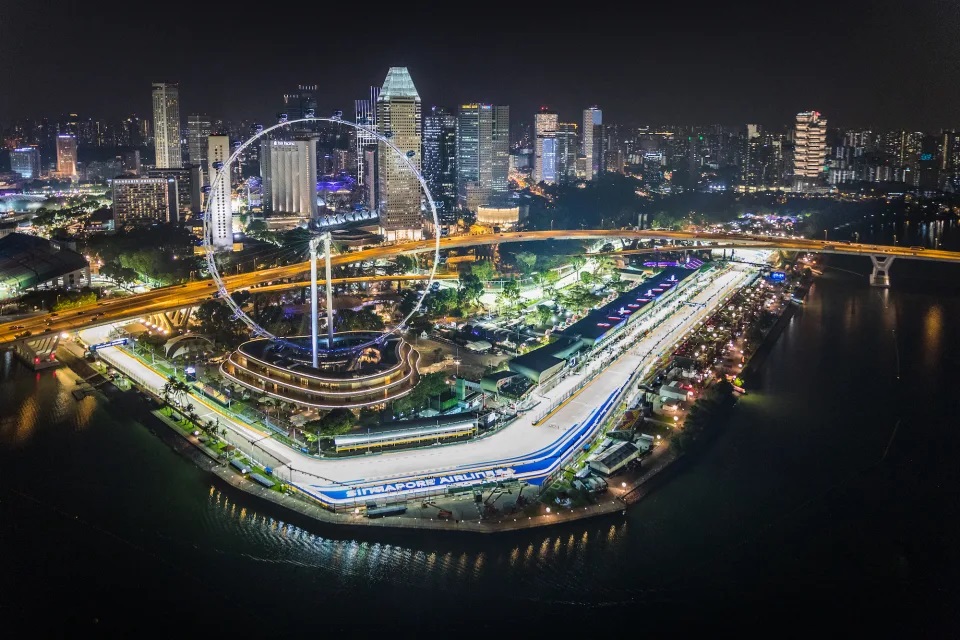
Teams and drivers consequently have to manage an unusual timetable, with the race start at 20:00 local, meaning breakfast in mid[1]afternoon, dinner in the early hours, and blackout curtains in hotel rooms essential. Singapore’s high temperatures and humidity levels also adds to the challenge for everyone in the team.
A new 4th DRS zone added for 2024
There are around seven thousand kilometres separating Baku and Singapore and the entire Formula 1 circus has just tackled yet another logistical challenge of this very long season, moving personnel, cars and equipment in a matter of a couple of days from the shores of the Caspian Sea to the city-state where the Malacca Straights meet the South China Sea. This is the first time these two races have been run back-to-back.
For the upcoming Singapore Grand Prix this weekend, the FIA has made last-minute changes to the Marina Bay street circuit, with the biggest one being the addition of a fourth DRS zone to the circuit for more overtaking opportunities.
Starting with the changes to the circuit, the pit lane has seen a significant adjustment this year, with the maximum speed reduced from 80 km/h to 60 km/h. This change could substantially affect race strategies, as drivers are expected to lose approximately 28 seconds on average due to the new speed limit.
Last year, the Marina Bay circuit saw a major overhaul with a new 400-meter straight replacing the former Turns 16-19. For the current season, additional changes include resurfacing at Turns 3, 9, 10, 12, 14, and 17. To enhance overtaking opportunities on this challenging street circuit, a new DRS zone has been added between Turns 14 and 16. As a result, Singapore, along with Australia, now features the most DRS zones on the F1 calendar.
In addition, Pirelli has decided to bring its softest tire to Singapore, starting with the C5 compound as the softest, while C4 will be medium, and C3 will be the hardest of the lot.
The circuit was modified last year with the aim of making it flow better, but it is still one of the twistiest of the season. Its length is now down to 4.940 kilometers so that the number of laps has been increased to 62. In the final sector, between what used to include turns 16 to 19, a 400-meter straight has replaced them so that the number of corners has been reduced from 23 to 19. The bitumen should be similar to that used on public roads generally open to city traffic, but with new asphalt, one can expect a smoother surface. One does not usually learn much from the first free practice session, but this time it will give everyone the opportunity to acquire important data relating to tire behavior.
Due to redevelopment work of The Float into NS Square, the old turns 16 to 19 are bypassed, creating a longer full-throttle section between turn 14 and the old turn 20, which is now turn 16.
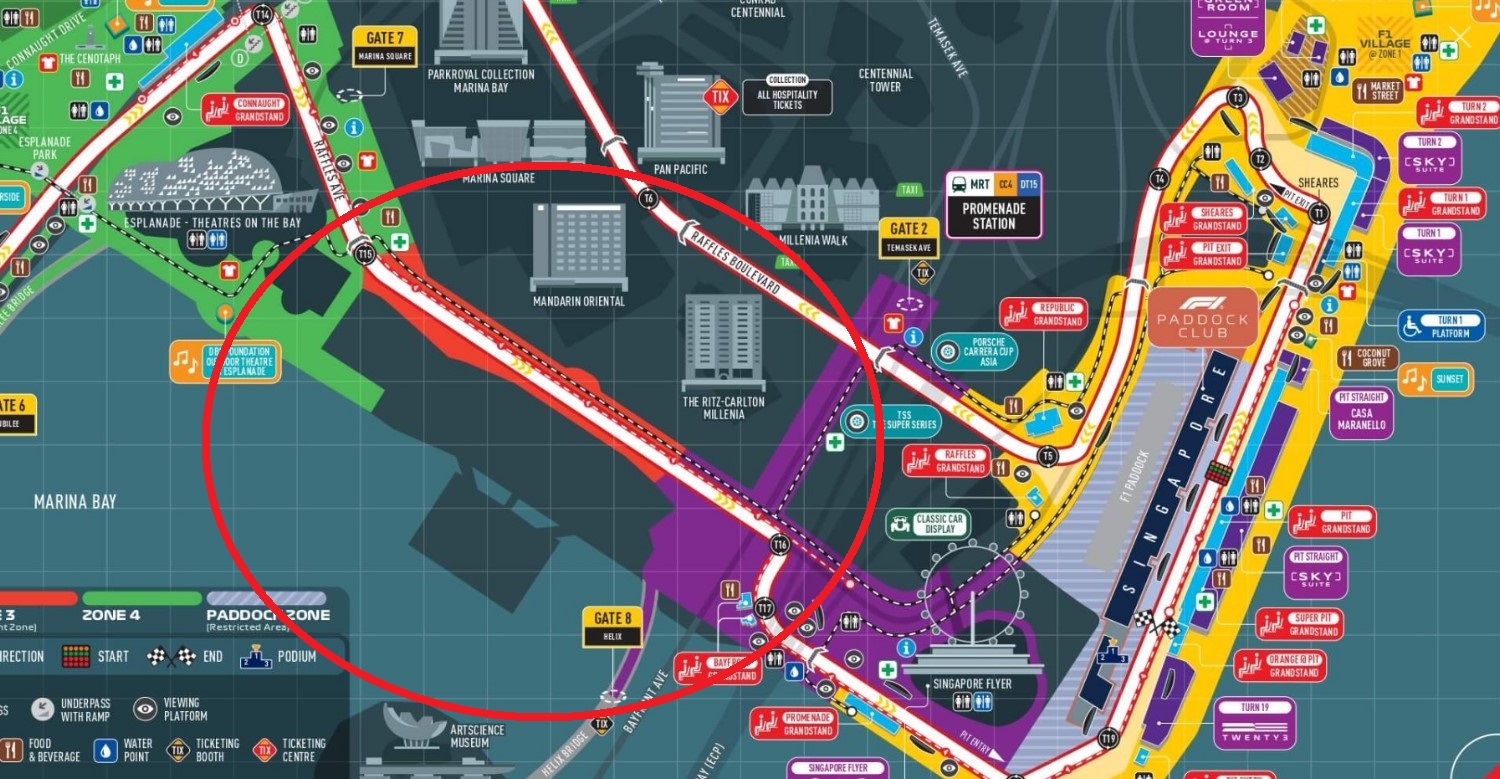
That has shaved 135 meters of distance from the lap, with the removal of the corners expected to lower lap time by almost 10 seconds, with turn 16 approached at greater speed.
The average lap speed is expected to be higher than previous years but Marina Bay remains among the circuits with the slowest lap speed, with Singapore’s grands prix regularly pushing towards the two-hour mark.
Singapore is a special race for the world of Formula One, too. It’s a peculiar one, a race in which to juggle European times on South-East Asian soil; a race of late wake-ups, even later bed times, heat and humidity. But far from being displeasing, these elements all make Singapore a race like no other: you haven’t really fully been in the sport unless you have a fun Singapore story to share
The bumpy circuit, located in the Marina Bay district, takes Formula 1 drivers past some of Singapore’s famous landmarks, including the National Gallery, the Esplanade Concert Hall, and Singapore Flyer. The floodlit architecture provides a stunning backdrop to one of Formula 1’s most challenging events.
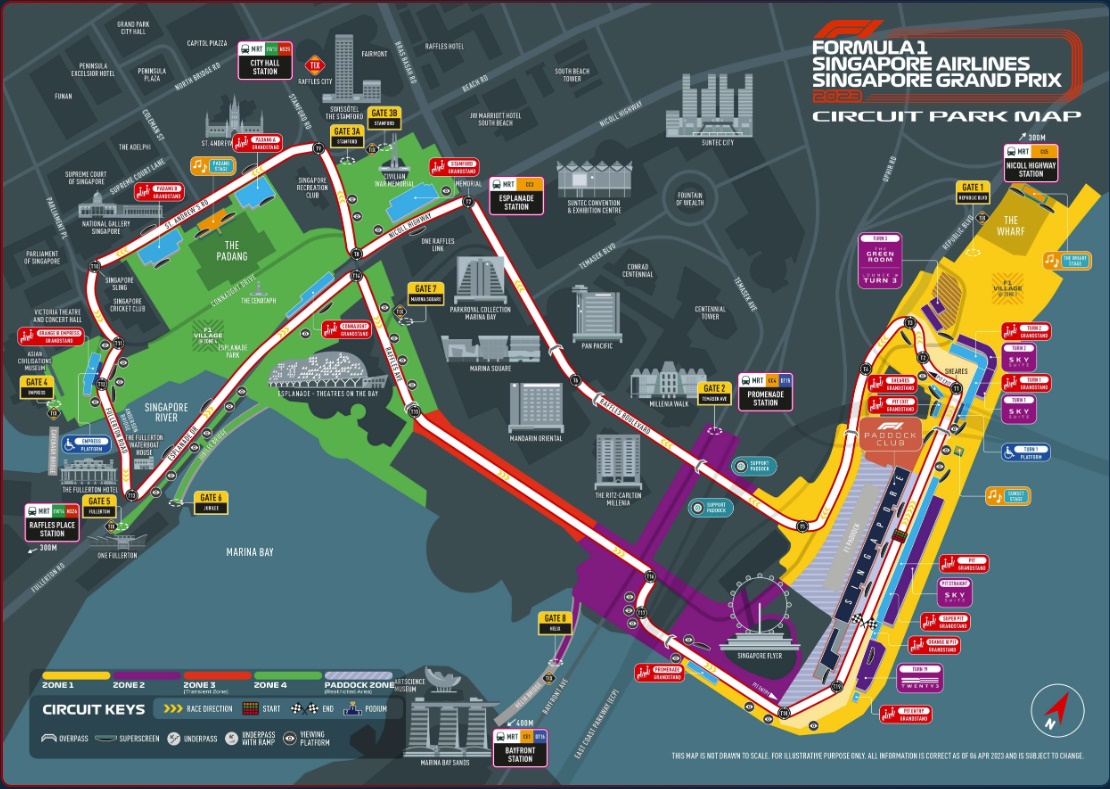
As with all street circuits, the slightest mistake in Singapore comes at a high price, given there are very few run-off areas and running a fraction off-line can see you in the barriers. Therefore, the Safety Car is a common sight here, especially as it takes quite a while to remove a stricken car from the track. There are a couple of factors that make the one-stop the only valid strategy: firstly, the time lost for a tire change pit stop is around 28 seconds, partly because the pit lane speed limit is reduced to 60 km/h and secondly, overtaking on this track is definitely complicated. A two-stop need only be considered in the event of the race being neutralized.
Weather Forecast
Friday, September 20: FP1 & FP2
Both practice sessions have a small chance of rain on Friday, with thundery showers around the circuit for most of the day, before clearing up in the evening ahead of the action. However, the unpredictability of the storms suggests the track may be wet when the cars take to the track for FP1.
Saturday, September 21: FP3 & Qualifying
Saturday evening is expected to be dry and sunny, once again following a daytime filled with thundery showers. Temperatures are expected to reach highs of 32 degrees Celsius at the Marina Bay Street circuit.
There is a 20% chance of rain in FP3, decreasing throughout the evening as we head into qualifying.
Sunday, September 22: Race
The track is expected to remain dry during the race with high temperatures throughout the day and into the evening, but 75% humidity forecast for the race start at 8pm (local time).
It will be 30 degrees Celsius from lights out, with just a 5% chance of rain affecting the race itself.
Fact File: Singapore Grand Prix
- This year’s Singapore Grand Prix will again feature the new layout as redevelopment works take place in the vicinity of the track.
- The circuit between what was Turns 16 to 19 will now become one long 397.9m straight, reducing the number of corners from 23 down to 19.
- The circuit length has therefore reduced from 5.063 km to 4.928 km and the number of laps of the Grand Prix increased from 61 to 62.
- Lap times are expected to be reduced by roughly 10 seconds due to the changes.
- The new layout will likely be beneficial for the tires; previously, they would begin to overheat towards the end of the lap, but the removal of four 90-degree corners should help them stay closer to the optimum operating window.
- Track evolution is incredibly high in Singapore, given that it is a street circuit. The surface can ramp up by as much as three seconds between FP1 on Friday and Qualifying on Saturday evening.
- The Singapore Grand Prix is one of the most physically demanding races of the season. The intense humidity, warm temperatures, combined with the stop/start nature of the track, make it very challenging.
- Due to these factors, drivers can lose around 3kg of weight during the race through sweating alone.
- That stop/start nature, with a requirement for constant re-acceleration, ensures the circuit has the biggest fuel effect of the year. In simple terms, that means the amount of time you lose each lap is higher for every kilogram of extra fuel in the car.
- Owing to the large amount of time spent in corners, just 50% of lap time is spent at full throttle.
- That is one of the lowest percentages of the season, with only Monaco, the Hungaroring, and the Autódromo Hermanos Rodríguez in Mexico with lower amounts.
- The Marina Bay Street Circuit has the largest number of heavy braking events of any circuit we visit at four.
- The lack of long straights and short distance between turns also puts less air through the brakes. Cooling is therefore a big focus for the team.
- The track is also very bumpy. That adds to the stress that the drivers and cars are put through – that is particularly true with these new generation cars that run lower to the ground.
- The circuit also impacts the tires as the surface temperatures can never properly cool down. The tarmac is also aggressive on the tires, increasing wear and degradation.
- With a speed limit of 60 km/h, and a layout that feeds in at turn two, the total pit lane time is the highest of the season at 25 seconds.
- Owing to the layout changes, the number of gear changes per lap has dropped to 64. It was previously the circuit with the highest amount of gear changes, but now ranks fourth overall.
- Given the nature of a street track, it is perhaps no surprise that all 13 of the previous Singapore Grands Prix have featured at least one Safety Car deployment.
- In the last five editions, we have seen 10 Safety Car deployments.
- This was the first ever Grand Prix to be run at night under floodlights and, visually, it has always provided a great show. As usual on a tight track, qualifying is almost the most important factor when it comes to the race result, which explains why nine of the 14 races held to date have been won from pole position. The King of Singapore is Sebastian Vettel, who won here five times, on four occasions from pole, while his total podium tally is eight. With the German quitting the sport in 2022, he could lose his crown to Lewis Hamilton who has the same number of poles and four wins to date, while he is also closing in on the German’s record for top three finishes, with seven.
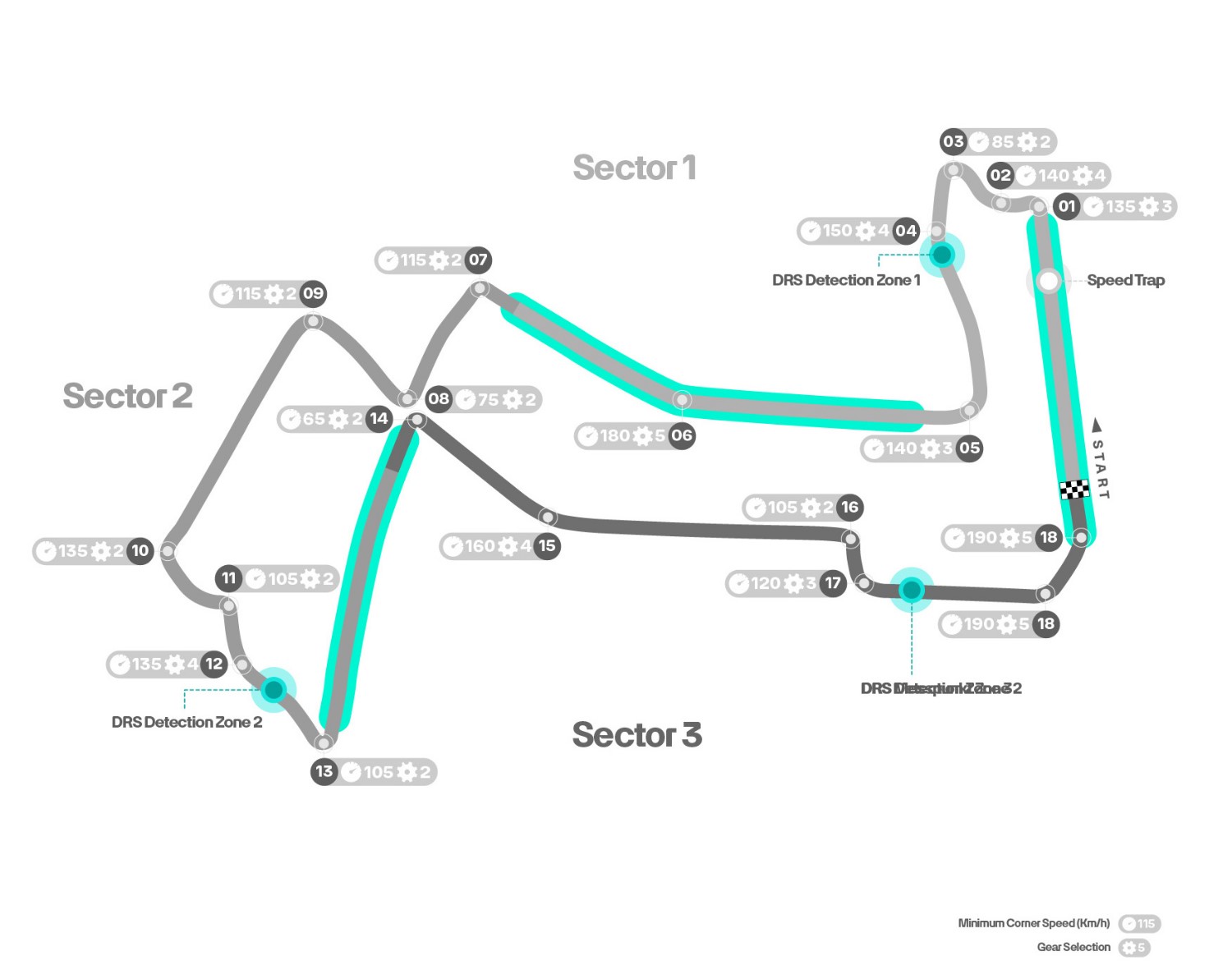
Heat and Humidity Aston Martin’s Andy Stevenson
From Baku’s Caspian Sea shoreline to Singapore’s spectacular Marina Bay. Ahead of the second leg of F1’s street race double-header, Aston Martin Aramco Sporting Director Andy Stevenson talks time zones, intense heat and humidity, and one of the most demanding racetracks in the world as he provides the lowdown on how the team will navigate the Singapore Grand Prix.
Singapore is unique as the paddock operates on a European time zone, despite local time being GMT+8. How does the team contend with this?
“You have to be very focused on the weekend schedule and ignore what the local time is. If you live on Singapore time and still work to the session times you’ll struggle.
“This year will be a little bit different to the past because we’re coming straight from Baku and we’ve already had a time change of three hours. In previous years, we’ve gone straight from the UK to Singapore and we’ve had a couple of days where people have adapted to the Singapore time zone and then had to flip back to Europe very quickly.
“It’s all about being disciplined. It’s all about making sure you get enough rest and it’s about eating at the right times. It’s very easy to fall into having lunch at lunchtime in Singapore when really you should be having breakfast. With the aid of the catering team, we make sure that we put meal times in the correct slots and that we’re serving the correct foods. We’re trying to trick the body into thinking that nighttime is daytime.”
Another challenge of Singapore is the heat and humidity. How do you and the team combat that?
“Acclimatization is key. You’ve got to go outside and get used to the heat and humidity – don’t sit in air conditioning all day. Singapore’s going to be hot, so expect it to be hot. Don’t think, ‘I’ll try and keep myself cool or tell my body that it’s not hot’, the more you accept it, the better you deal with it.
“The most crucial thing is taking on enough liquid. You’ve got to make sure that you keep yourself hydrated and if you stop sweating, there’s something wrong.
“I don’t suffer with the heat much but it’s different for everybody, which over the years we’ve learned through bringing in professional doctors and physios via Formula Medicine.
“Some people’s bodies are just better at adapting than others so as a team we’ve got to look out for one another.
“Our team doctor, Rahul Chotai, will be checking in all the time and I’ll do the same – I’m constantly watching to make sure that everybody is alert and still feeling fit and healthy. We have some busy days in Singapore and it’s very important to look out for the welfare for everybody.”
This race weekend comes immediately after the previous round in Azerbaijan. Has that created different challenges compared to travelling straight to Singapore from the UK?
“Double-headers are tough, even if you reduce the travel between the Grands Prix , but we have introduced systems and more resource to make the transition more efficient, so it’s not been much of an issue.
“Our primary focus is performance on track; we don’t want to be burning everybody out moving tonnes of equipment around, we need them to be focused on their job.
“We’ve got a great team and we have a lot of processes in place to try to make things as smooth as possible so going from Azerbaijan or from the UK doesn’t matter too much, as we’re always prepared.”
How will the team fare on the streets of Singapore this weekend?
“There are such fine margins at the moment. What we have, generally speaking, is a fantastic championship. F1 has finally got what everyone has wanted for a long time with different cars being able to win but, unfortunately, we’re toward the back of that group of cars at the moment.
“It’s so competitive; Fernando was less than a tenth behind Lewis Hamilton’s Mercedes in Qualifying in Baku, and that car won a race not long ago.
“We’re around fifth-fastest wherever we go and it’s probably going to be similar in Singapore but, as we saw in Azerbaijan, if we execute everything well we can be ready to pick up extra points from any incidents ahead.”
After Singapore there are four weeks without a Grand Prix. Is this gap in the calendar an important opportunity to recharge before the final flyaway rounds of the season? What will you be doing in the break?
“We’ve always got work to do and we’re always trying to improve, so we can always make use of anybody who wants to come to work! The gap in the calendar does give the race team the opportunity to take some holiday and draw a breath, though.
“That opportunity isn’t there for everybody because there’s a lot of work that still needs doing, and I’m looking forward to having some time where I can focus on longer-term projects and tasks.
“For much of the season we’re going from race to race so having that little break in the schedule is great for me to catch up on things and do some planning for next season.
“I think the break will be good for everybody, whether they get time to have a holiday or just a break from travelling, because the final part of the season is going to be really busy with two triple-headers and three Sprint events.
“Having said that, after a very short time away from the circuit I’m always itching to get back to the track. I can’t wait to head to Austin next month for the United States Grand Prix.”
What to watch for
Race interruptions: Being a street track, it is perhaps no surprise that all 14 of the previous Singapore Grands Prix have featured at least one Safety Car deployment. In the last six editions, we have seen 11 Safety Car deployments.
Overtaking: This is one of the hardest venues at which to overtake, second only to Monaco. With an alternative layout this year, with Turns 16-19 removed and replaced by a straight, there might be an increased number of overtakes in the Grand Prix. Historically, the first DRS zone has been the prime passing place.
Strategy: A one-stop strategy is expected to be the fastest one at Marina Bay, given the pit loss of 27 seconds – the highest of any circuit on the calendar thanks to the 60km/h speed limit and tricky pit entry. Pirelli is bringing the softest trio of compounds to Singapore for maximum grip on a twisty and demanding track.
Unlocking the Lap
The lap begins with a short run to the opening three turns. Turn One is a medium-speed left-hander that exits onto a shallow right-hand bend and immediately leads to a sharp left-hander. A long straight follows to Turn Five, where it’s important to use all of the entry curb to maximize your exit and carry as much speed as you can down Raffles Boulevard, the first of three DRS zones.

Turn Seven is a hard braking zone followed by 90-degree corners in Turns Eight and Nine. Turn 10 is the Singapore Sling, a medium-speed left-hander that leads into a pair of fast corners that exit onto Fullerton Road, a short straight that bends to the right – making the entry into the Turn 13 hairpin tricky.
The second DRS zone follows Turn 13, leading onto the sharp Turn 14 right-hander. The following straight – with a left-hand kink – could prove conducive to overtaking, with the Turns 16-17 chicane ending that high-speed run. The lap finishes with two high-speed left-hand corners, Turns 18 and 19, and the start-finish straight with another DRS zone.
All eyes on Verstappen – Can Red Bull Recover?
“We have learned from what we did wrong last week in Baku and can try a few things differently this week in Singapore.
“Marina Bay is a cool circuit but we do expect this to be a bit more of a challenge, as it has been historically. The race is usually quite close here and obviously very hot and humid.
“The changes that we initially made in Baku were positive and we were heading in the right direction; we think we know what we can do better and of course need to make sure that we are optimizing the set up. It will be important to keep the car in control a bit more in the slow speed so it doesn’t jump around and this should hopefully help us a lot.
“Finally, we are continuing to fight for the Championship: we win and lose as a Team and are going to keep pushing and try and come back stronger.”
Sergio Perez likes street circuits
“It was such a shame in Baku for the whole Team, so much hard work had gone into getting a more competitive car on track for us and it was really showing.
“We had the pace all weekend and now it’s about converting that pace into a podium in Singapore. The car has shown it’s capable with this package, so we need to get the set-up right across the weekend and execute our qualifying and race plan perfectly.
“I’ve won in Singapore before, in tricky conditions and, as everyone knows, I love a street circuit, there’s something special about a night race and this one is probably the best there is.
“On Sunday night I want us to be able to say we did the best we could to win this race and that’s what our full focus will be on from the moment we start work in Singapore.”
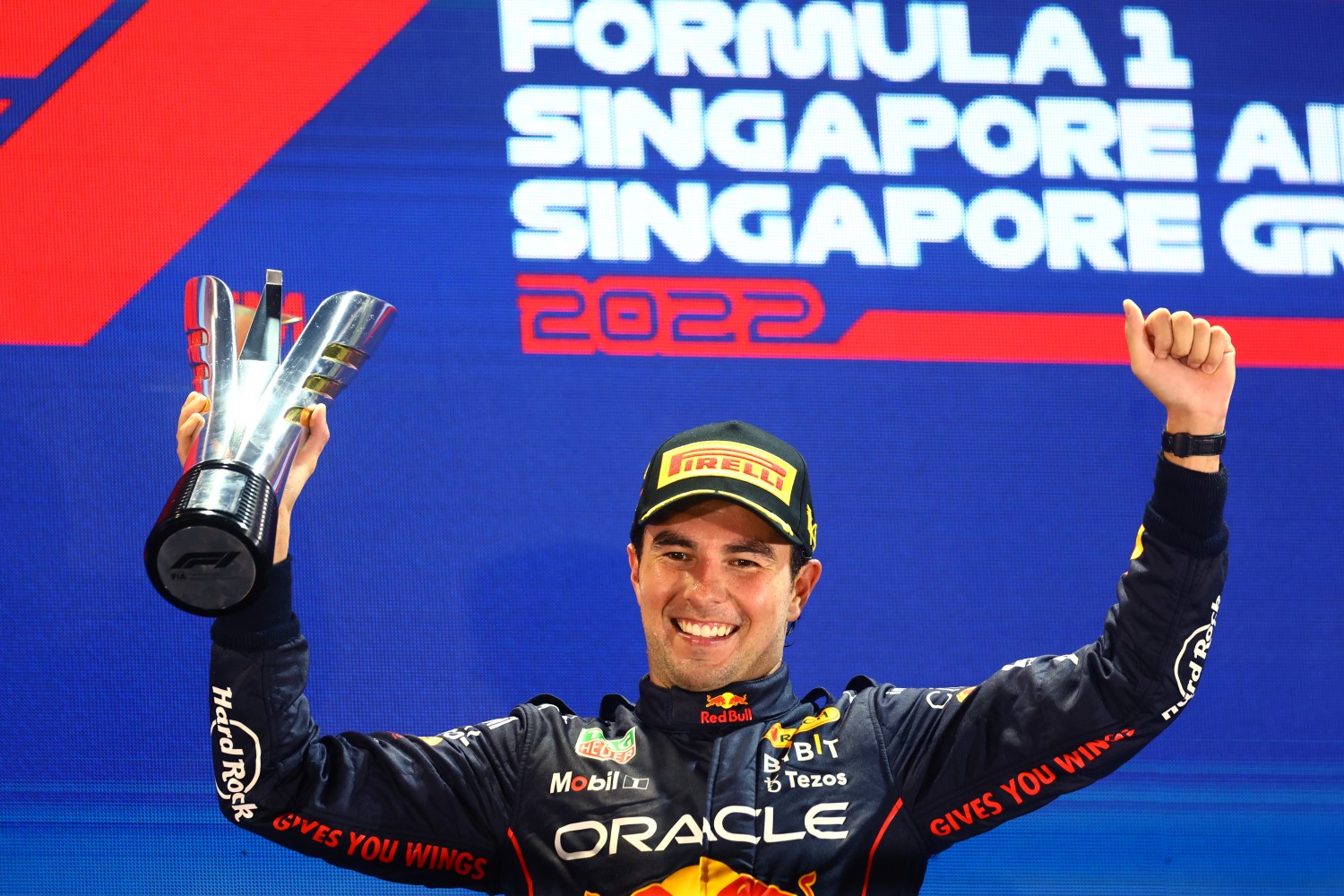
Driver Perspective – Daniel Ricciardo – Visa Cash App RB F1 Team:
“I really enjoy the Marina Bay Street Circuit. It’s one of my favorite tracks. I didn’t race here last year, so I’m looking forward to being back. It’s super hot and humid, which is an additional challenge. Hopefully we can perform better than what we showed in Baku. We’re working hard as a Team to understand this and improve. I’m excited to get back on this track and try to score some points.”
Pirelli Tires
Here on the Equator, the dry weather compounds chosen for the 15th running of the Singapore Grand Prix are the same as last year’s and in fact the same as at the past two races at Monza and Baku, on tracks each with very different characteristics: C3 as Hard, C4 as Medium and C5 as Soft.
